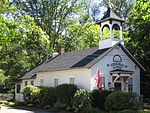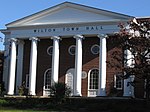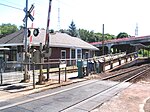Cannondale, Connecticut

Cannondale is a census-designated place (CDP) within the town of Wilton in Fairfield County, Connecticut. It had a population of 141 at the 2010 census. The neighborhood consists of many old homes on large, almost rural lots now largely wooded. The English first settled the land in the 17th century. At the center of Cannondale is Cannon Crossing, a small shopping village of boutiques and restaurants made up of 19th-century buildings restored by actress June Havoc in the late 1970s on the east side of Cannondale Railroad Station. Both are part of Cannondale Historic District, which encompasses the central part of Cannondale and most of its significant historical buildings. The area was originally called "Pimpewaug" by the local Indians, and it was the name originally used by the colonial settlers. The Cannon family became prominent in the area, in part because of the Cannon Store, which started operating in the 1790s. In March 1852, the Danbury and Norwalk Railroad opened a station in the neighborhood, near where the tracks crossed Cannon Road, and named it Cannon Station. Soon after, Charles Cannon began a campaign to get a post office in the neighborhood, and on April 29, 1870 it became a reality in a store east of the railroad tracks (very probably in a building which also functioned as a general store and the train station). At this time, the neighborhood became known as "Cannon Station". In 1882, the U.S. Post Office changed the local office's name to "Cannon", then changed it back to Cannon Station in 1896. The similarity of "Cannon" and "Canaan", a town on the northern border of the state, caused residents to want a further adjustment in the name. In November 1915 the post office name was changed to Cannondale. The post office was closed in 1967 but the name remains, generally covering an area centered on the intersection of Danbury Road and Cannon Road.In 1915, Samuel Miller, who was instrumental in the final name change, acquired a cannon which had been used in the Civil War battle of Galveston. It was placed at the intersection of Danbury and Cannon roads and toppled twice, once as a Halloween prank and another time in an automobile accident.
Excerpt from the Wikipedia article Cannondale, Connecticut (License: CC BY-SA 3.0, Authors, Images).Cannondale, Connecticut
Cannon Road,
Geographical coordinates (GPS) Address Nearby Places Show on map
Geographical coordinates (GPS)
| Latitude | Longitude |
|---|---|
| N 41.216388888889 ° | E -73.425277777778 ° |
Address
Cannon Road 37
06897
Connecticut, United States
Open on Google Maps









